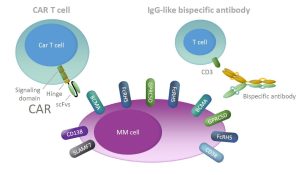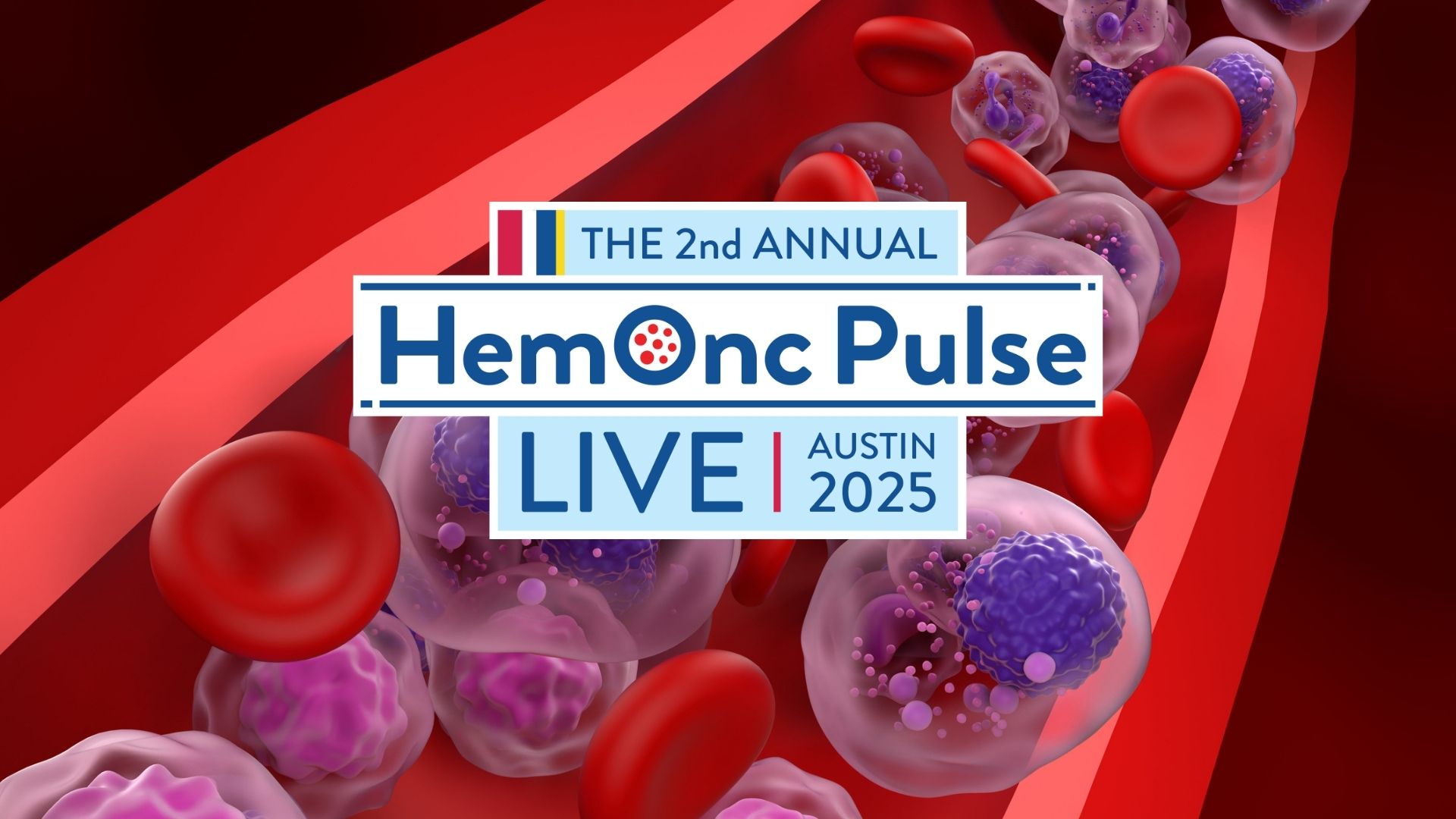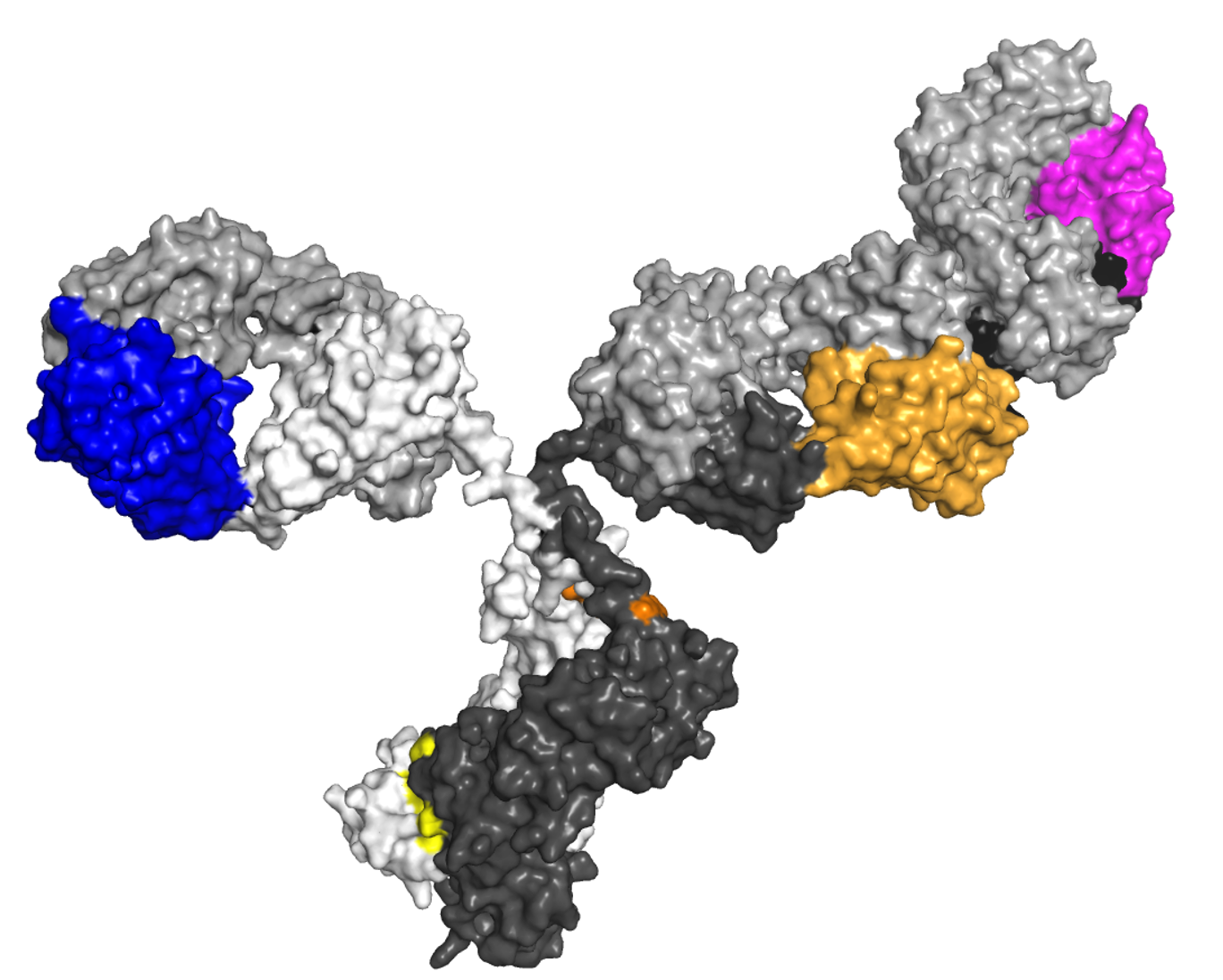
Multiple myeloma (MM) patients who develop disease refractory to immunomodulatory drugs (IMiDs), proteasome inhibitors (PIs), and CD38-targeting antibodies (triple-class refractory disease) have a poor outcome and an as yet unmet medical need for new effective therapies. The LocoMMotion study is providing real-world data on outcomes in triple-class exposed MM patients receiving standard-of-care therapies. The first analysis of this prospective study showed that triple-class exposed patients (74% triple-class refractory) had an overall response rate (ORR) of only 20% with standard-of-care salvage therapies.1 Similarly, the MAMMOTH study, which retrospectively investigated the clinical outcomes of patients refractory to CD38 antibodies, showed a median overall survival of <12 months for triple-class refractory patients, and 5.6 months for penta-refractory patients (disease refractory to 2 IMiDs, 2 PIs, and CD38 antibodies).2 This clearly indicates that new agents with a novel mechanism of action are needed to treat these patients. Promising in this respect are the different T-cell redirecting therapies currently under investigation in heavily pretreated MM patients.
Bispecific antibodies
T-cell redirecting bispecific antibodies (BsAbs) have the ability to simultaneously target CD3 on the T-cell surface and a tumor-associated antigen on the tumor cell surface (Figure). This results in the formation of an immune synapse and subsequent release of granzymes and perforins, resulting in lysis of the tumor cell.3 A big advantage of BsAbs is that these agents are available directly “off-the-shelf,” which is especially important for patients with rapidly progressive disease.4 There are different BsAb formats, with two BsAb classes predominantly evaluated in clinical trials. These include IgG-like BsAbs and bispecific T-cell engagers (BiTEs), which consist of two single-chain variable fragment (scFv) units fused with a short flexible linker. Because of their small size, BiTEs need to be administered via continuous infusion, while the IgG-like BsAbs can be given via intermittent intravenous or subcutaneous dosing, which is more convenient for patients.

B-cell maturation antigen (BCMA)s is the target of several BCMA-specific BsAbs, because of its restrictive expression pattern, and thereby low risk for “on target/off tumor” toxicities. BCMA is expressed only on normal plasma cells and a subset of mature B-cells, as well as on MM cells. Pacanalotamab (formerly AMG 420), the first-in-class BCMA-specific BiTE molecule, was evaluated in heavily pretreated patients with a median of 5 prior lines of therapy. The ORR at the maximum tolerated dose was 70% (7 of 10 patients), which included minimal residual disease (MRD)-negative complete response (CR) in 50%.5 Development of pacanalotamab was stopped, however, because of the need for continuous infusion. A study with a half-life extended BiTE molecule, pavurutamab (formerly AMG 701), administered as weekly intravenous infusion, is ongoing, with an ORR of 83% in the most recently reported cohort.6
Among other BCMA-targeting BsAbs under evaluation in heavily pretreated MM, the most advanced in terms of clinical testing is teclistamab.7 Teclistamab is an IgG-like antibody that was shown to effectively eliminate BCMA-positive MM cell lines and primary MM cells in in vitro assays, accompanied by T-cell activation and degranulation.8 Teclistamab was also effective in MM mouse models.9 Based on these preclinical results, the MajesTEC-1 study was initiated, which to date has administered teclistamabin to a total of 157 patients, intravenously in 84 and subcutaneously in 73.7 The recommended phase 2 dose (RP2D) was defined as teclistamab 1500 μg/kg administered subcutaneously after two step-up doses to mitigate cytokine-release syndrome (CRS). In the most recent report of the study, 40 patients were treated at the RP2D (median of 5 prior lines of therapy and 83% triple-class refractory). Teclistamab was well tolerated with no new safety signals. Hematologic toxicity occurred mainly during the first and second treatment cycles. The most common non-hematologic adverse event was CRS (70% of patients), which occurred a median of 1 day after injection, and did not reach grade ≥3, and did not lead to treatment discontinuation in any patient. The ORR in patients treated at the RP2D was 65%, including very good partial response (VGPR) or better in 58% and CR or better in 40%. Responses were durable with the RP2D; 85% of responders were alive and continuing on treatment after a median follow-up of 7.1 months.7
Elranatamab (formerly PF-06863135), another BCMA-targeting BsAb, was initially evaluated as an intravenous infusion, but in the phase 1 study (MagnetisMM-1) update, presented at the 2021 annual meetings of the European Hematology Association (EHA)10 and the American Society of Clinical Oncology (ASCO),11 it was administered subcutaneously in 30 patients (86.7% triple-class refractory). At the RP2D (1000 μg/kg) the overall response rate was 83.3% (n=6 patients). Responses were also reported in patients who were previously exposed to BCMA-targeted therapies. The most common adverse events were again hematologic toxicity and CRS. Preliminary results from several other BCMA-targeting BsAbs, including CC-93269 (alnuctamab),12 REGN5458,13 and TNB-383B,14 have also shown promising response rates with CRS as most common adverse event.
Recently it was reported that BCMA loss may be a mechanism of acquired resistance to BCMA-bispecifics.15 Although it is not known how often this occurs, this case report highlighted the importance of identifying new MM-associated antigens for T-cell redirection therapy. In this respect, T-cell redirecting antibodies targeting GPRC5D or FcRH5 are promising in terms of activity and safety. GPRC5D is a protein that is highly expressed on plasma and myeloma cell surfaces, and also on cells that produce keratin.16,17 Talquetamab is the first-in-class GPRC5D-specific T-cell redirecting BsAb that was shown to eliminate MM cells in different preclinical assays.16,18,19 An update from the phase 1 MonumenTAL-1 study showed that at the time of data cut-off a total of 184 patients were enrolled (102 received intravenous dosing and 82 subcutaneous dosing).18 The RP2D for talquetamab has now been determined as 405 μg/kg administered subcutaneously. Toxicities again include hematologic toxicity and CRS, but also, uniquely to GPRC5D targeting with talquetamab, skin toxicity and dysgeusia (probably related to GPRC5D expression in these tissues). These toxicities were effectively managed with supportive care. Talquetamab was active in these heavily pretreated patients (approximately 80% triple-class refractory) with an ORR of 70% with VGPR or better, in 60% of the 30 patients treated at the RP2D.
FcRH5, another myeloma-associated antigen, forms the target for cevostamab.20,21 As well as normal and malignant plasma cells, FcRH5 is also expressed on B cells.21 The ORR with cevostamab at the 3.6/20 mg dose level was 53%.20 A recent update presented at EHA 2021 showed that response to cevostamab was consistent regardless of previous therapies.20 FcRH5 expression was also not altered by the number of prior lines and or types of prior therapy.
These different BsAbs are in further development as monotherapy and some of these new agents also in combination with other anti-MM agents, such as CD38 antibodies or IMiDs, to further improve depth and duration of response. In addition, an ongoing study (NCT04586426) is also evaluating the combination of teclistamab and talquetamab in RRMM. Dual antigen targeting may prevent development of antigen escape and thereby potentially improve durability of response. Studies with BsAbs are also planned in patients with newly diagnosed MM or with early relapse.
Conclusion
BsAbs are promising new agents that harness the power of T cells to eliminate MM cells. Recent data demonstrated that these novel therapies for the treatment of MM patients show a beneficial balance between activity and toxicity. Ongoing trials will answer several outstanding questions, such as how to best sequence these new T-cell redirecting therapies and which patients will experience most benefit from them.
Niels W.C.J. van de Donk, MD, PhD, is professor of hematology and professor of cancer immunology at Amsterdam University Medical Center, Vrije Universiteit Amsterdam, and the Department of Hematology, Cancer Center Amsterdam in The Netherlands. Prof. van de Donk’s special interests are the treatment of patients with multiple myeloma and he is involved in translational research towards finding new targets for therapy with a focus on immunotherapy.
References
- Mateos M-V, Weisel K, Stefano VD, et al. LocoMMotion: A prospective, non-interventional, multinational study of real-life current standards of care in patients with relapsed/refractory multiple myeloma (RRMM) receiving ≥3 prior lines of therapy. J Clin Oncol. 2021;39(15 Suppl):Abstract 8041. DOI: 10.1200/JCO.2021.39.15_suppl.8041
- Gandhi UH, Cornell RF, Lakshman A, et al. Outcomes of patients with multiple myeloma refractory to CD38-targeted monoclonal antibody therapy. Leukemia. 2019;33(9):2266-2275. DOI: 10.1038/s41375-019-0435-7
- Verkleij CPM, Korst CLBM, van de Donk NWCJ. Immunotherapy in multiple myeloma: when, where, and for who? Curr Opin Oncol. 2020;32(6):664-671. DOI: 10.1097/CCO.0000000000000677
- van de Donk NWCJ, Usmani SZ, Yong K. CAR T-cell therapy for multiple myeloma: state of the art and prospects. Lancet Haematol. 2021;8(6):e446-e461. DOI: 10.1016/S2352-3026(21)00057-0
- Topp MS, Duell J, Zugmaier G, et al. Anti-B-cell maturation antigen BiTE molecule AMG 420 induces responses in multiple myeloma. J Clin Oncol.2020;38(8):775-783. DOI: 10.1200/JCO.19.02657
- Harrison B, Minnema M, Lee HC, et al. A Phase 1 first in human (FIH) study of AMG 701, an anti-B-cell maturation antigen (BCMA) half-life extended (HLE) BiTE® (bispecific T-cell engager) molecule, in relapsed/refractory (RR) multiple myeloma (MM). Blood. 2020;136(Suppl 1):28-29. DOI: 10.1182/blood-2020-134063
- Usmani SZ, Garfall AL, van de Donk N, et al. Teclistamab, a B-cell maturation antigen × CD3 bispecific antibody, in patients with relapsed or refractory multiple myeloma (MajesTEC-1): a multicentre, open-label, single-arm, phase 1 study. Lancet. 2021;398(10301):665–674. DOI: 10.1016/S0140-6736(21)01338-6
- Frerichs KA, Broekmans MEC, Marin Soto JA, et al. Preclinical activity of JNJ-7957, a novel BCMA×CD3 bispecific antibody for the treatment of multiple myeloma, is potentiated by daratumumab. Clin Cancer Res. 2020;26(9):2203-2215. DOI: 10.1158/1078-0432.CCR-19-2299
- Pillarisetti K, Powers G, Luistro L, et al. Teclistamab is an active T cell-redirecting bispecific antibody against B-cell maturation antigen for multiple myeloma. Blood Adv. 2020; 4(18):4538-4549. DOI: 10.1182/bloodadvances.2020002393
- Costello C, Raje N, Bahlis N, et al. MagnetisMM-1: Phase 1 study of elranatamab (PF-06863135), a B-cell maturation antigen (BCMA) targeted CD3-engaging bispecific antibody, for patients with relapsed or refractory multiple myeloma (MM). HemaSphere. 2021:5(S2):52. Abstract S192. DOI: 10.1097/HS9.0000000000000566
- Bahlis NJ, Raje NS, Costello C, et al. Efficacy and safety of elranatamab (PF-06863135), a B-cell maturation antigen (BCMA)-CD3 bispecific antibody, in patients with relapsed or refractory multiple myeloma (MM). J Clin Oncol. 2021;39(15_suppl):Abstract 8006. DOI: 10.1200/JCO.2021.39.15_suppl.8006
- Costa L, Wong S, Bermudez A, et al. Interim results from the first phase 1 clinical study of the B-cell maturation antigen (BCMA) 2+1 T-cell engager (TCE) CC-93269 in patients (pts) with relapsed/refractory multiple myeloma (RRMM). HemaSphere. 2020;4(S1):59. Abstract S205. DOI: 10.1097/HS9.0000000000000404
- Madduri D, Rosko A, Brayer J, et al. REGN5458, a BCMA x CD3 bispecific monoclonal antibody, induces deep and durable responses in patients with relapsed/refractory multiple myeloma (RRMM). Blood. 2020;136(Suppl 1):41–42. Abstract 291. DOI: https://doi.org/10.1182/blood-2020-139192
- Rodriguez C, D’Souza A, Shah N, et al. Initial results of a phase I study of TNB-383B, a BCMA x CD3 bispecific T-cell redirecting antibody, in relapsed/refractory multiple myeloma. Blood. 2020;136(Suppl 1):43-44. Abstract 293. DOI: 10.1182/blood-2020-139893
- Truger M, Dull J, Zhou X, et al. Single And double hit events in genes encoding for immunotherapy targets in multiple myeloma. HemaSphere. 2021:5(S2):43. Abstract S175. DOI: 10.1097/HS9.0000000000000566
- Verkleij CPM, Broekmans MEC, van Duin M, et al. Preclinical activity and determinants of response of the GPRC5DxCD3 bispecific antibody talquetamab in multiple myeloma. Blood Adv. 2021;5(8):2196-2215. DOI: 10.1182/bloodadvances.2020003805
- Smith EL, Harrington K, Staehr M, et al. GPRC5D is a target for the immunotherapy of multiple myeloma with rationally designed CAR T cells. Sci Transl Med. 2019;11(485):eaau7746. DOI: 10.1126/scitranslmed.aau7746
- Berdeja JG, Krishnan AY, Oriol A, et al. Updated results of a phase 1, first-in-human study of talquetamab, a G protein-coupled receptor family C group 5 member D (GPRC5D) × CD3 bispecific antibody, in relapsed/refractory multiple myeloma (MM). J Clin Oncol. 2021;39(15 Suppl):Abstract 8008. DOI: 10.1200/JCO.2021.39.15_suppl.8008
- Pillarisetti K, Edavettal S, Mendonça M, et al. A T-cell-redirecting bispecific G-protein-coupled receptor class 5 member D x CD3 antibody to treat multiple myeloma. Blood. 2020;135(15):1232-sss1243. DOI: https://doi.org/10.1182/blood.2019003342
- Sumiyoshi T, Nakamura R, Lear S, et al. FcRH5 target expression in patients with relapsed refractory multiple myeloma (RRMM) treated with cevostamab in an ongoing Phase I dose escalation study. HemaSphere. 2021:5(S2):452. Abstract EP965. DOI: 10.1097/HS9.0000000000000566
- Li J, Stagg NJ, Johnston J, et al. Membrane-proximal epitope facilitates efficient T cell synapse formation by anti-FcRH5/CD3 and Is a requirement for myeloma cell killing. Cancer Cell. 2017;31(3):383-395. DOI: 10.1016/j.ccell.2017.02.001






 © 2025 Mashup Media, LLC, a Formedics Property. All Rights Reserved.
© 2025 Mashup Media, LLC, a Formedics Property. All Rights Reserved.